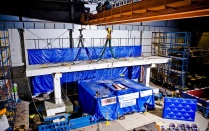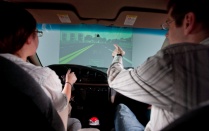Sharing the potential of game engines to enhance transportation
Investigators
Co-Investigators
Roman Dmowski - Robotics Engineer, Bosch
Prajit Kumar - UB MAE
Rajyavardhan Karra - UB Data Science alum
Rachel Lim - former engineering associate with the ISTL Motion Simulation Laboratory (MSL)
Meredith Finn - UB MAE alum, former MSL student assistant
Project Description
At the 2023 Modeling and Simulation (MODSIM) World 2023 Conference in Norfolk, Virginia, ISTL Director Kevin Hulme, PhD, and his team of transportation engineering researchers presented their findings in the application of different video game engine simulations to enhance transportation research.
Game engines are software frameworks generally used to develop video games that contain different settings and configurations to advance and streamline development. Hulme and others implemented the two of the most popular game engines, Unity and Unreal, to generate different modeling and simulation experiences to analyze the different ways humans interact with vehicles and other transportation subjects.
The Unity game engine is featured across mobile, console, virtual reality and desktop games, including some popular games like “Pokemon Go”, "Beat Saber", and "Hollow Knight". Hulme’s Unity game engine implementation examines human distraction in transportation.
“The first implementation implements the Unity game engine for the creation of a ground transportation network to support the analysis of distraction potential, during manual operation, amidst navigational information sources that can be internal or external to both the vehicle and the driver,” Hulme says.
The Unreal engine has been used in a multitude of console, desktop, mobile and virtual reality platforms, including games like "Assetto Corsa Competizione", "A Hat in Time", and "Fortnite". Hulme’s team is implementing this engine for predictive purposes.
“The second implementation implements the Unreal game engine for the creation of a test and evaluation network to forecast future modes of human transport during autonomous operation, particularly hybrid ground-flight vehicles and Advanced Air Mobility,” Hulme says.










